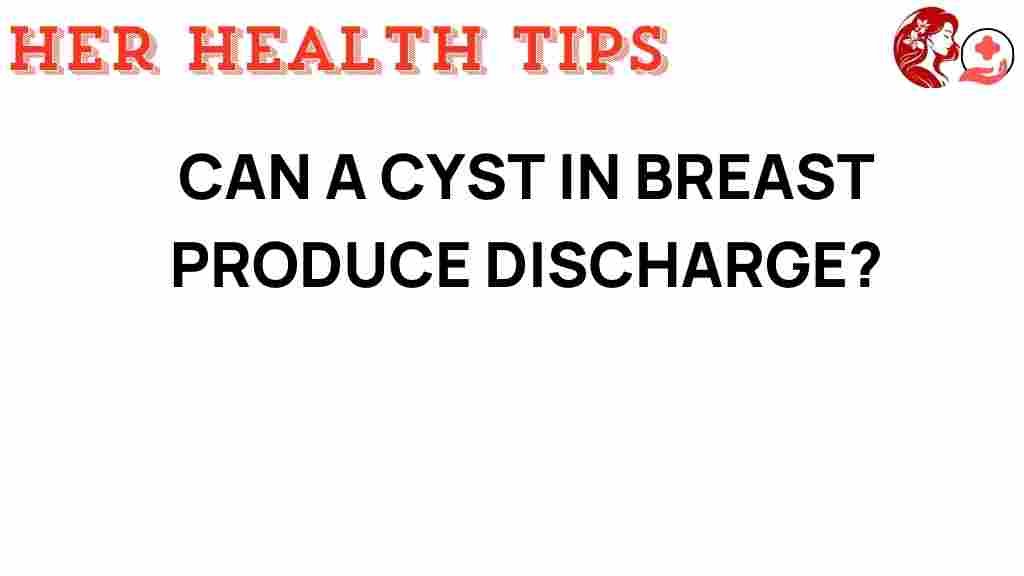Unraveling the Mystery: Can a Breast Cyst Cause Discharge?
Breast health is a critical aspect of women’s health that often raises questions and concerns. One common issue that many women experience is the presence of breast cysts. While breast cysts are generally benign, they can sometimes cause discharge, leading to confusion and anxiety. In this article, we will explore the relationship between breast cysts and discharge, discussing the symptoms, diagnosis, and health implications, as well as offering medical advice and tips on what to do if you experience these symptoms.
Understanding Breast Cysts
A breast cyst is a fluid-filled sac that forms in the breast tissue. These cysts can vary in size and may be discovered during a routine breast examination or imaging tests such as a mammogram or ultrasound. While they are most common in women aged 30 to 50, breast cysts can occur at any age.
Symptoms of Breast Cysts
Many women with breast cysts may not experience any symptoms. However, when symptoms do occur, they may include:
- Palpable Lump: A firm or soft lump in the breast that can be felt.
- Breast Discomfort: Tenderness or discomfort in the area of the cyst.
- Changes in Size: The cysts may enlarge or shrink with hormonal changes, particularly during the menstrual cycle.
- Discharge: Some women may notice discharge from the nipple when pressure is applied to the breast.
Can Breast Cysts Cause Discharge?
Yes, breast cysts can cause discharge in some cases. The discharge is typically clear, straw-colored, or yellowish and is usually not associated with any pain. However, it is essential to understand that not all breast cysts will produce discharge, and the presence of discharge can also be caused by other conditions.
Types of Discharge from the Breast
Understanding the different types of discharge may help in assessing breast health:
- Clear or Yellowish Discharge: Often associated with breast cysts.
- Bloody Discharge: May indicate a more serious condition and should be evaluated by a healthcare professional.
- Green or Brown Discharge: Can be related to other benign conditions such as duct ectasia.
Diagnosis of Breast Cysts
If you notice a lump in your breast or experience discharge, it is crucial to seek medical advice. A healthcare provider will typically conduct the following steps for diagnosis:
- Physical Examination: A thorough examination of the breast to assess the lump and any associated symptoms.
- Imaging Tests: Ultrasound or mammogram may be ordered to visualize the cyst and differentiate it from other conditions.
- Fluid Aspiration: In some cases, a doctor may perform a fine-needle aspiration to extract fluid from the cyst for analysis.
When to Seek Medical Advice
It is vital to consult a healthcare professional if you experience any of the following symptoms:
- New or unusual breast lump.
- Persistent or increasing breast pain.
- Discharge that is bloody or occurs spontaneously.
- Changes in the skin of the breast or nipple.
These signs may indicate conditions that require further evaluation and treatment.
Potential Conditions Related to Breast Cysts and Discharge
While breast cysts are generally benign, there are other conditions that can cause similar symptoms:
- Fibrocystic Breast Changes: A common condition that leads to lumpy or ropy breast tissue and may cause discharge.
- Intraductal Papilloma: A benign tumor that can form in the milk ducts and often causes bloody discharge.
- Breast Infection (Mastitis): An infection that can lead to pain, swelling, and discharge, often requiring antibiotics.
- Breast Cancer: Although rare, discharge can be a symptom of breast cancer, particularly if it is bloody or occurs without squeezing.
Step-by-Step Process for Managing Breast Cysts
Here is a step-by-step process to help manage breast cysts and any associated discharge:
- Self-Examination: Regularly check your breasts for any lumps or changes in texture.
- Monitor Symptoms: Keep track of any discharge, noting its color and consistency.
- Consult a Healthcare Provider: Schedule an appointment if you notice any concerning symptoms.
- Follow Diagnostic Recommendations: Attend any imaging or diagnostic tests your doctor suggests.
- Discuss Treatment Options: If diagnosed with a breast cyst, discuss management options, which may include monitoring or aspiration if necessary.
- Stay Informed: Educate yourself about breast health and any new developments in medical advice regarding breast conditions.
Troubleshooting Tips for Managing Discharge and Breast Cysts
If you are experiencing discharge and have been diagnosed with breast cysts, consider the following troubleshooting tips:
- Warm Compress: Applying a warm compress can relieve discomfort associated with cysts.
- Avoid Irritants: Limit the use of harsh soaps or lotions on the breast area to reduce irritation.
- Maintain a Healthy Lifestyle: Regular exercise and a balanced diet can contribute to overall breast health.
- Regular Check-Ups: Keep up with annual breast exams and screenings as recommended by your healthcare provider.
Conclusion
In conclusion, breast cysts can sometimes cause discharge, but understanding the nature of the discharge and accompanying symptoms is essential for maintaining breast health. If you notice any changes in your breasts, including lumps or unusual discharge, it’s crucial to seek medical advice promptly. Early diagnosis and appropriate management can help ensure that any potential issues are addressed efficiently.
Remember, while breast cysts are common and often benign, staying vigilant about your breast health is vital. For more information on breast health, consider visiting this resource for guidance on symptoms and conditions related to women’s health.
For those looking for more in-depth knowledge, we recommend consulting healthcare professionals or accessing resources like the American Cancer Society for information on breast health and cancer awareness.
This article is in the category Conditions and created by HerHealthTips Team
